Solar eclipse of January 15, 2010
| Solar eclipse of January 15, 2010 | |
|---|---|
|
Annularity from Bangui, Central African Republic | |
 Map | |
| Type of eclipse | |
| Nature | Annular |
| Gamma | 0.4002 |
| Magnitude | 0.919 |
| Maximum eclipse | |
| Duration | 668 sec (11 m 8 s) |
| Coordinates | 1°36′N 69°18′E / 1.6°N 69.3°E |
| Max. width of band | 333 km (207 mi) |
| Times (UTC) | |
| (P1) Partial begin | 4:05:28 |
| (U1) Total begin | 5:13:55 |
| Greatest eclipse | 7:07:39 |
| (U4) Total end | 8:59:04 |
| (P4) Partial end | 10:07:35 |
| References | |
| Saros | 141 (23 of 70) |
| Catalog # (SE5000) | 9529 |
The solar eclipse of January 15, 2010 was an annular eclipse of the Sun with a magnitude of 0.9190. A solar eclipse occurs when the Moon passes between Earth and the Sun, thereby totally or partly obscuring the image of the Sun for a viewer on Earth. An annular solar eclipse occurs when the Moon's apparent diameter is smaller than the Sun's, blocking most of the Sun's light and causing the Sun to look like an annulus (ring). An annular eclipse appears as a partial eclipse over a region of the Earth thousands of kilometres wide. It was the longest annular solar eclipse of the millennium,[1] and the longest until December 23, 3043, with a maximum length of 11 minutes, 7.8 seconds. This is about 4 minutes longer than total solar eclipses could ever get. (The solar eclipse of January 4, 1992, was longer, at 11 minutes, 41 seconds, occurring in the middle of the Pacific Ocean.)[2]
The eclipse was visible as only a partial eclipse in much of Africa, Eastern Europe, the Middle East and Asia. It was seen as an annular eclipse within a narrow stretch of 300 km (190 mi) width across Central Africa, Maldives, South Kerala (India), South Tamil Nadu (India), Sri Lanka and parts of Bangladesh, Burma and China.
Visibility of the eclipse
The eclipse started in the Central African Republic, traversed Cameroon, DR Congo and Uganda, passed through Nairobi, Kenya, and passed over the Indian Ocean, where it reached its greatest visibility. It then entered Maldives, where it was the longest on land with 10.8 viewable minutes. The annular eclipse at Malé, the capital city of Maldives, started at 12:20:20 and ended at 12:30:06 Maldives local time (UTC+5). This was also the longest duration of any eclipse with an international airport in its track.[3]
At approximately 13:20 IST, the annular solar eclipse entered India at Thiruvananthapuram (Trivandrum), Kerala and exited India at Rameswaram, Tamil Nadu.
The eclipse was viewable for 10.4 minutes in India. After Rameswaram, it entered Sri Lanka at Delft Island, exited at Jaffna in Sri Lanka, crossed the Bay of Bengal and re-entered India in Mizoram.
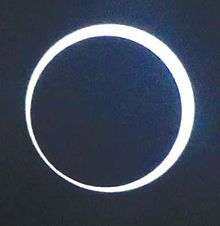
Thiruvananthapuram, which was the entry point of the eclipse in India, was equipped with telescopes and announced facilities for the public to view the eclipse.[4] Vikram Sarabhai Space Centre, situated in Trivandrum, analysed the atmospheric-ionospheric parameters during the eclipse.[5] Many scientists camped in the city to witness and study the eclipse.[6]
At Rameswaram, the sunrise was not visible due to thick clouds, but it started getting clear at around 9 AM local time and became almost totally clear by the time the eclipse began. The sky had a thin layer of cirrus clouds till 2:30PM. Among the eclipse-watchers was Sky Watchers' Association of North Bengal (SWAN) from Siliguri at the foothills of West Bengal and Tamil Nadu Astronomical Association.
Dhanushkodi, which falls on the central line of the eclipse, was a good place to view the eclipse. The northernmost limit of shadow in India was Cuddalore, Neyveli, Erode, Kodaikanal, and Madurai. Other prime viewing locations in Tamil Nadu include Thoothukudi and Cape Comorin, 22 km north of the center line. The exact location of the line is between the NH end and the Dhanushkodi ruins. Dhanushkodi is about 2 km east of the central line. The degree difference is about 0.2 between the central line – with Kodandaramar Temple and Dhanushkodi ruins vice versa. Dhanushkodi is about 5 km from the Kodandaramar Temple.
After South Asia, annularity passed Myanmar and China before leaving the Earth.
Gallery

 Eclipse taken against the Nallur Kandaswamy temple, Jaffna District, Sri Lanka.
Eclipse taken against the Nallur Kandaswamy temple, Jaffna District, Sri Lanka. Eclipse taken at Jaffna Hindu College, Jaffna District, Sri Lanka.
Eclipse taken at Jaffna Hindu College, Jaffna District, Sri Lanka.
 Animation of path
Animation of path Stages of solar eclipse in Thiruvananthapuram, India.
Stages of solar eclipse in Thiruvananthapuram, India. Photograph of the eclipse seen from Chennai, India
Photograph of the eclipse seen from Chennai, India
 Montage of the eclipse from Degania A, Israel, from 05:03 UT to 07:05 UT
Montage of the eclipse from Degania A, Israel, from 05:03 UT to 07:05 UT Photograph of the ending stages of the eclipse as seen from Chennai
Photograph of the ending stages of the eclipse as seen from Chennai Photograph of Partial Stage from Pallipalayam, Tamil Nadu, India.
Photograph of Partial Stage from Pallipalayam, Tamil Nadu, India. Reflection of Solar Eclipse on floor due to holes at roof in Palliapalayam, Tamil Nadu, India.
Reflection of Solar Eclipse on floor due to holes at roof in Palliapalayam, Tamil Nadu, India. Satellite image of the Moon's shadow falling on India and the Bay of Bengal.
Satellite image of the Moon's shadow falling on India and the Bay of Bengal.
Related eclipses
Solar eclipses 2008-2011
Each member in a semester series of solar eclipses repeats approximately every 177 days and 4 hours (a semester) at alternating nodes of the Moon's orbit.
| Solar eclipse series sets from 2008–2011 | ||||
|---|---|---|---|---|
| Ascending node | Descending node | |||
| Saros | Map | Saros | Map | |
121 Partial from Christchurch |
2008 February 7 Annular |
126 Novosibirsk, Russia |
2008 August 1 Total | |
131 Bandar Lampung, Indonesia |
2009 January 26 Annular |
136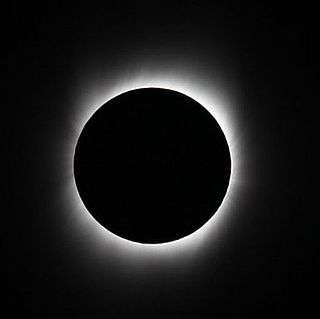 Kurigram, Bangladesh |
2009 July 22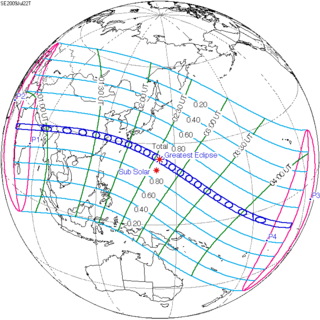 Total | |
| 141 Bangui, Central African Republic |
2010 January 15 Annular |
146 Hao, French Polynesia |
2010 July 11 Total | |
151 Partial from Vienna, Austria |
2011 January 4 Partial (north) |
156 | 2011 July 1 Partial (south) | |
| Partial solar eclipses on June 1, 2011, and November 25, 2011, occur on the next lunar year eclipse set. | ||||
Saros 141
Solar Saros 141 repeats every 18 years, 11 days and contains 70 events. The series started with partial solar eclipse on May 19, 1613. It contains annular eclipses from August 4, 1739 through October 14, 2460. There are no total eclipses in this series. The series ends at member 70 as a partial eclipse on June 13, 2857. [7]
| Series members 17–28 occur between 1901 and 2100 | ||
|---|---|---|
| 17 | 18 | 19 |
 November 11, 1901 |
 November 22, 1919 |
 December 2, 1937 |
| 20 | 21 | 22 |
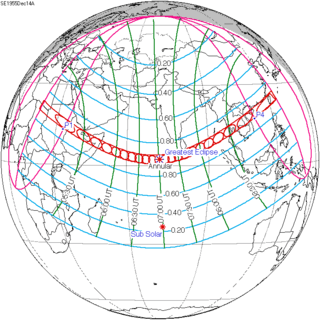 December 14, 1955 |
 December 24, 1973 |
 January 4, 1992 |
| 23 | 24 | 25 |
 January 15, 2010 |
 January 26, 2028 |
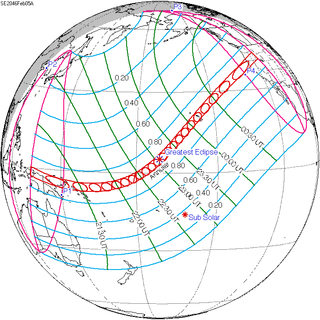 February 5, 2046 |
| 26 | 27 | 28 |
 February 17, 2064 |
 February 27, 2082 |
 March 10, 2100 |
Metonic series
The metonic series repeats eclipses every 19 years (6939.69 days), lasting about 5 cycles. Eclipses occur in nearly the same calendar date. In addition the octon subseries repeats 1/5 of that or every 3.8 years (1387.94 days).
| 21 eclipse events, progressing from north to south between June 10, 1964 and August 21, 2036 | ||||
|---|---|---|---|---|
| June 10–11 | March 27–29 | January 15–16 | November 3 | August 21–22 |
| 117 | 119 | 121 | 123 | 125 |
 June 10, 1964 |
 March 28, 1968 |
 January 16, 1972 |
 November 3, 1975 |
 August 22, 1979 |
| 127 | 129 | 131 | 133 | 135 |
 June 11, 1983 |
 March 29, 1987 |
 January 15, 1991 |
 November 3, 1994 |
 August 22, 1998 |
| 137 | 139 | 141 | 143 | 145 |
 June 10, 2002 |
 March 29, 2006 |
 January 15, 2010 |
 November 3, 2013 |
 August 21, 2017 |
| 147 | 149 | 151 | 153 | 155 |
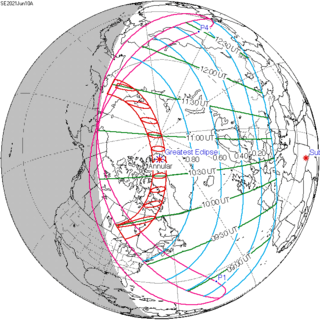 June 10, 2021 |
 March 29, 2025 |
 January 14, 2029 |
 November 3, 2032 |
 August 21, 2036 |
Notes
- ↑ NASA – Solar Eclipse Search Engine
- ↑ Annular Solar Eclipse Occurs on January 15, 2010
- ↑ NASA: Eclipses During 2010: Annular Solar Eclipse of January 15
- ↑ Facilities to view the solar eclipse in Trivandrum
- ↑ VSSC expects insights from eclipse
- ↑ City Bureau (January 14, 2010). "Celestial treat, a day away". The Hindu.
- ↑ "NASA - Catalog of Solar Eclipses of Saros 141". Eclipse.gsfc.nasa.gov. Retrieved 2012-03-15.
References
- Earth visibility chart and eclipse statistics Eclipse Predictions by Fred Espenak, NASA/GSFC
- NASA: Eclipses During 2010: Annular Solar Eclipse of January 15
- Eclipse.org.uk: Annular eclipse of the Sun: 2010 January 15
- http://astronomyindia.org
- www.sciencemaldives.org: January 15th 2010 Solar Eclipse, Maldives
- Hermit.org Visibility graphics
- www.eclipser.ca: Jay Anderson 2010 January 15 Annular Solar Eclipse
External links
| Wikimedia Commons has media related to Solar eclipse of 2010 January 15. |
- Annular Solar Eclipse of Dali, Yunnan, China
- SpaceWeather.com: January 15, 2010 solar eclipse
- Eclipse over the Temple of Poseidon, APOD 1/18/2010, partial eclipse of Sounion, Greece
- Millennium Annular Solar Eclipse, APOD 1/22/2010, annularity of Kanyakumari, India, the same picture chosen as APOD again on 5/19/2012, Annular Solar Eclipse
- Eclipses in the Shade, APOD 1/23/2010, from Alif Alif Atoll, Maldives
- Annular Eclipse Over Myanmar, APOD 1/26/2010, annularity of Ananda Temple, Bagan, Myanmar
- 2010 Annular Eclipse January 15, 2010, from India by Jay Pasachoff
- Solar Eclipse animation of January 15, 2010
- ShadowAndSubstance.com: January 15, 2010, solar eclipse animations for geographical locations
- Solar Eclipse pictures
- Eclipse photography taken from Rameswaram, Tamil Nadu, India
- Eclipse-Chasers: January 15, 2010 annular solar eclipse
- SWAN Website
